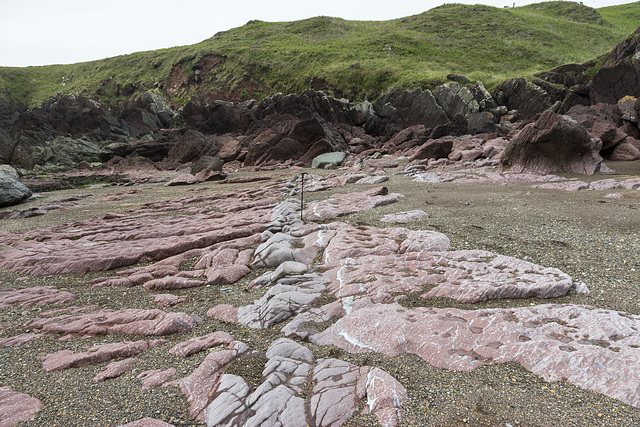Gravel Bay - Moor Cliffs Formation 2
Gravel Bay - millipede-like burrows in Moor Cliffs…
Gravel Bay - Moor Cliffs Formation with calcretes…
Gravel Bay - Moor Cliffs Formation with calcretes…
Gravel Bay - calcrete horizon in Moor Cliffs Forma…
Gravel Bay - Moor Cliffs Formation
East Pickard Bay panorama
East Pickard Bay - English stonecrop
Waves in Freshwater West
Druidston Haven: Cliff Section 6
Druidston Haven: Cliff Section 6 interpretation
Druidston Haven: Cliff Section 5
Druidston Haven: Cliff Section 5 interpretation
Druidston Haven: Cliff Section 4
Druidston Haven: Cliff Section 4 interpretation
Druidston Haven: Cliff Section 3
Druidston Haven: Cliff Section 3 interpretation
Druidston Haven: Cliff Section 2
Druidston Haven: Cliff Section 2 interpretation
Druidston Haven: Cliff Section 1 panorama
Druidston Haven: Cliff Section 1 interpretation
St Brides Haven solifluction deposit
St Brides Haven: colourful rocks, colourful sea
Freshwater West walkies
Spray haze over Freshwater West
Moody sky over Freshwater West
Conglomerate at Gravel Bay: close-up view 2
Conglomerate at Gravel Bay: close-up view 1
Conglomerates at Gravel Bay
Raasay: Churchton Bay, Ferry, and Ben Tianavaig on…
Raasay: Churchton Bay and Ben Tianavaig on Skye
Raasay: Inverarish from mine tramway
Raasay: No.1 Ironstone Mine adit entrance (intake)…
Raasay: No.1 Ironstone Mine adit entrance (intake)…
Raasay: No.1 Ironstone Mine adit entrance (intake)…
Raasay: No.1 Ironstone Mine tramway with silver bi…
Raasay: No.1 Mine tramway viaduct and tributary bu…
Raasay: No.1 Mine tramway viaduct - north pier
Raasay: No.1 Mine tramway viaduct piers
Raasay: Tramway junction
Raasay: No.2 Mine tramway view from winding house…
Raasay: No.2 Mine tramway winding house interior
Raasay: No.2 Mine tramway winding house
Raasay: view north along ironstone mine tramway
Raasay: view south along ironstone mine tramway
1/125 • f/6.3 • 15.0 mm • ISO 100 •
Canon EOS 600D
EF-S15-85mm f/3.5-5.6 IS USM
Location
See also...
Keywords
Authorizations, license
-
Visible by: Everyone -
All rights reserved
-
157 visits
Gravel Bay - Moor Cliffs Formation 1


Freshwater West, Gravel Bay and East Pickard Bay
Moor Cliffs Formation in Gravel Bay.
This photo shows the wave cut platform in the Moor Cliffs Formation at the western end of Gravel Bay. A light purple sandstone bed is seen in the centre of the photo with red mudstones below (left) and above (right). The white mottling towards the right is a particularly well-developed calcrete horizon. The sequence is dipping to the north (right) at approx. 60°.
The walking stick is about 0.9 m long.
Background:
The Moor Cliffs Formation overlies the Freshwater East conglomerates, seen in previous photos, and spans the boundary between the Silurian and Devonian periods. It consists of red mudstones and siltstones with occasional thin sandstone beds. These were deposited on a low-reflief floodplain at the edge of an arid continental margin, the sandstones being deposited by seasonal braided streams, the muds and silts deposited in ephemeral marginal lakes. When not inundated, the muds and silts developed carbonate-rich calcrete (caliche) soil horizons along dessication cracks, burrows and early plant root systems.
Moor Cliffs Formation in Gravel Bay.
This photo shows the wave cut platform in the Moor Cliffs Formation at the western end of Gravel Bay. A light purple sandstone bed is seen in the centre of the photo with red mudstones below (left) and above (right). The white mottling towards the right is a particularly well-developed calcrete horizon. The sequence is dipping to the north (right) at approx. 60°.
The walking stick is about 0.9 m long.
Background:
The Moor Cliffs Formation overlies the Freshwater East conglomerates, seen in previous photos, and spans the boundary between the Silurian and Devonian periods. It consists of red mudstones and siltstones with occasional thin sandstone beds. These were deposited on a low-reflief floodplain at the edge of an arid continental margin, the sandstones being deposited by seasonal braided streams, the muds and silts deposited in ephemeral marginal lakes. When not inundated, the muds and silts developed carbonate-rich calcrete (caliche) soil horizons along dessication cracks, burrows and early plant root systems.
- Keyboard shortcuts:
Jump to top
RSS feed- Latest comments - Subscribe to the comment feeds of this photo
- ipernity © 2007-2024
- Help & Contact
|
Club news
|
About ipernity
|
History |
ipernity Club & Prices |
Guide of good conduct
Donate | Group guidelines | Privacy policy | Terms of use | Statutes | In memoria -
Facebook
Twitter

Sign-in to write a comment.